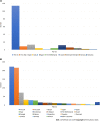May 2022 acute hepatitis outbreak, is there a role for COVID-19 and other viruses?
- PMID: 37034240
- PMCID: PMC10075009
- DOI: 10.4254/wjh.v15.i3.364
May 2022 acute hepatitis outbreak, is there a role for COVID-19 and other viruses?
Abstract
There has been an increasing number of reported cases of acute hepatitis of unknown origin in previously healthy children since first reported on March 31, 2022. This clinical syndrome is identified by jaundice and markedly elevated liver enzymes with increased aspartate transaminase and/or alanine aminotransaminase (greater than 500 IU/L). We conducted an inclusive literature review with respect to acute hepatitis outbreaks in children using the search terms acute hepatitis, outbreak, children, severe acute respiratory syndrome coronavirus 2 (SARS-CoV-2), coronavirus disease 2019 (COVID-19), and adenovirus. According to the cumulative data presented in four main studies, the median age is 4 years, with a male predominance (1.3:1). Jaundice was the most common clinical manifestation (69%), followed by vomiting (63%), anorexia (52.9%), diarrhea (47.2%), abdominal pain (39%), pyrexia (33.3%), pale stool (30%), and dark urine (30%). Coryza and lethargy were reported in 16.6%, while pruritus was reported in 2% of cases. Acute liver failure was observed in 25% of cases. The exact mechanism of this acute hepatitis outbreak is still not entirely clear. Adenoviruses and SARS-CoV-2 were detected in a significant number of patients. Coinfection with adenovirus and SARS-CoV-2 could be a possible underlying mechanism. However, other possible infections and mechanisms must be considered in the pathogenesis of this condition. Acute hepatitis of unknown origin in children has been a serious problem since the start of the COVID-19 pandemic but has not yet been sufficiently addressed. Many questions remain regarding the underlying mechanisms leading to acute liver failure in children, and it is likely that extensive future research is needed.
Keywords: Acute hepatitis of unknown origin; Adenovirus; COVID-19; Children; Hepatic failure; SARS-CoV-2.
©The Author(s) 2023. Published by Baishideng Publishing Group Inc. All rights reserved.
Conflict of interest statement
Conflict-of-interest statement: All authors declare that they have no competing interests.
Figures





Similar articles
-
Acute Hepatitis of Unknown Origin in Children: Early Observations from the 2022 Outbreak.J Clin Transl Hepatol. 2022 Jun 28;10(3):522-530. doi: 10.14218/JCTH.2022.00281. Epub 2022 Jun 22. J Clin Transl Hepatol. 2022. PMID: 35836761 Free PMC article. Review.
-
Editorial: Acute Hepatitis of Unknown Origin in Children. Is Autoimmunity at Play?Med Sci Monit. 2022 Jun 4;28:e937371. doi: 10.12659/MSM.937371. Med Sci Monit. 2022. PMID: 35707853 Free PMC article.
-
Paediatric acute hepatitis of unknown aetiology: a national investigation and adenoviraemia case-control study in the UK.Lancet Child Adolesc Health. 2023 Nov;7(11):786-796. doi: 10.1016/S2352-4642(23)00215-8. Epub 2023 Sep 26. Lancet Child Adolesc Health. 2023. PMID: 37774733
-
Acute Hepatitis of Unknown Etiology Among Young Children: Research Agenda by the ESPGHAN Hepatology Committee.J Pediatr Gastroenterol Nutr. 2022 Oct 1;75(4):543-548. doi: 10.1097/MPG.0000000000003567. Epub 2022 Sep 20. J Pediatr Gastroenterol Nutr. 2022. PMID: 35848740
-
The clinical characteristics and SARS-CoV-2 infection in children of acute hepatitis with unknown aetiology: A meta-analysis and systematic review.PLoS One. 2024 Dec 5;19(12):e0311772. doi: 10.1371/journal.pone.0311772. eCollection 2024. PLoS One. 2024. PMID: 39636900 Free PMC article.
Cited by
-
Acute hepatitis of unknown aetiology in children: evidence for and against causal relationships with SARS-CoV-2, HAdv and AAV2.BMJ Paediatr Open. 2024 Dec 9;8(1):e002410. doi: 10.1136/bmjpo-2023-002410. BMJ Paediatr Open. 2024. PMID: 39653515 Free PMC article. Review.
References
-
- World Health Organization. Disease Outbreak News; Multi-Country – Acute, severe hepatitis of unknown origin in children. [cited 23 April 2022]. Available from: https://www.who.int/emergencies/disease-outbreak-news/item/2022-DON376 .
-
- Mogul DB, Ling SC, Murray KF, Schwarzenberg SJ, Rudzinski ER, Schwarz KB. Characteristics of Hepatitis B Virus-associated Hepatocellular Carcinoma in Children: A Multi-center Study. J Pediatr Gastroenterol Nutr. 2018;67:437–440. - PubMed
Publication types
LinkOut - more resources
Full Text Sources
Miscellaneous

